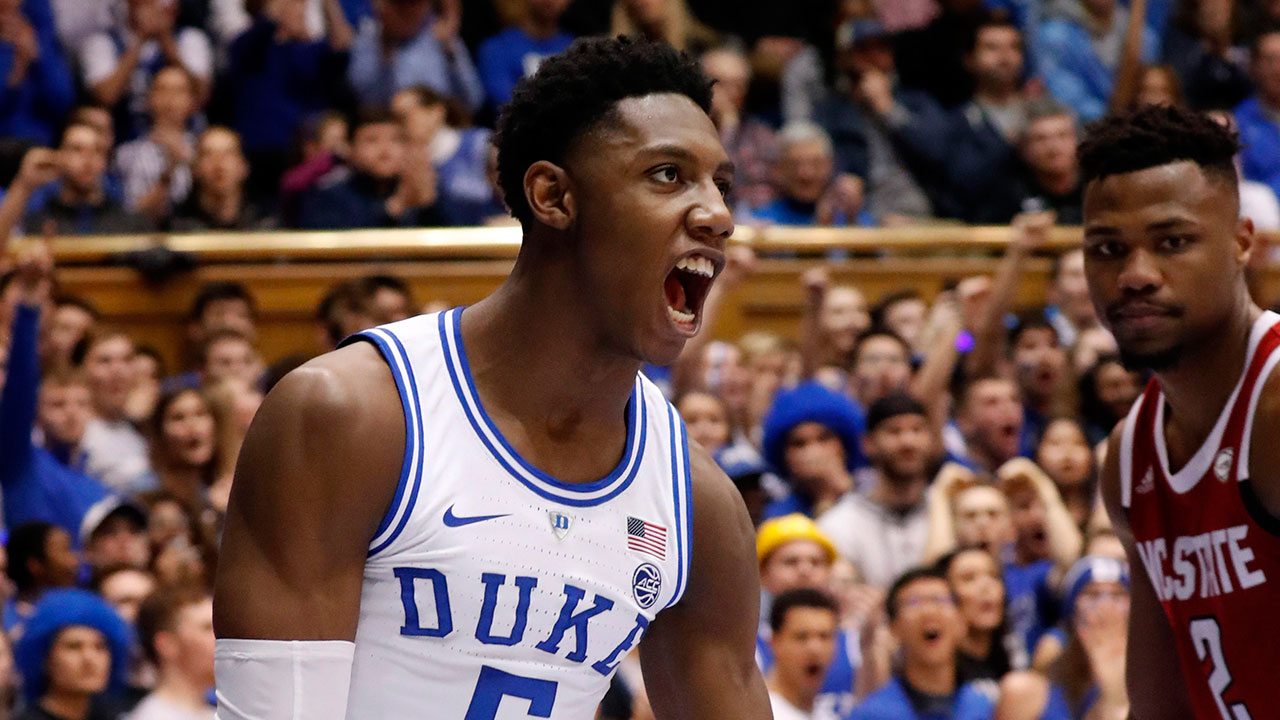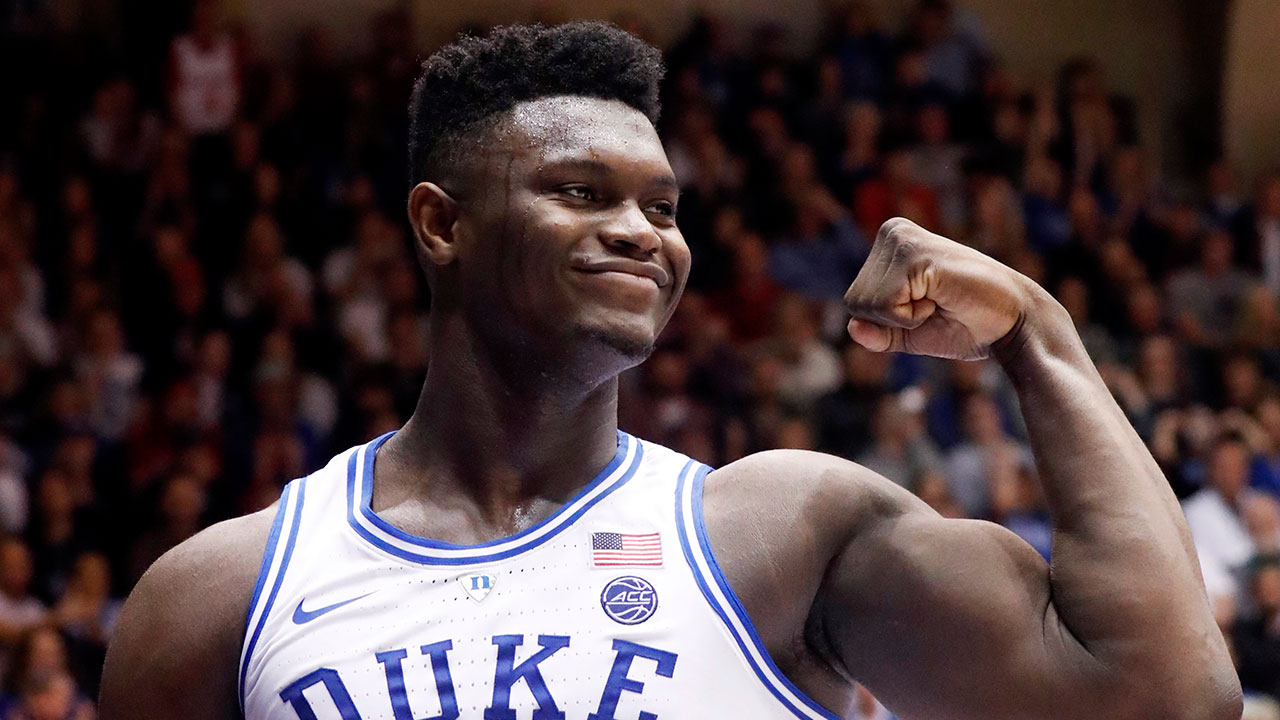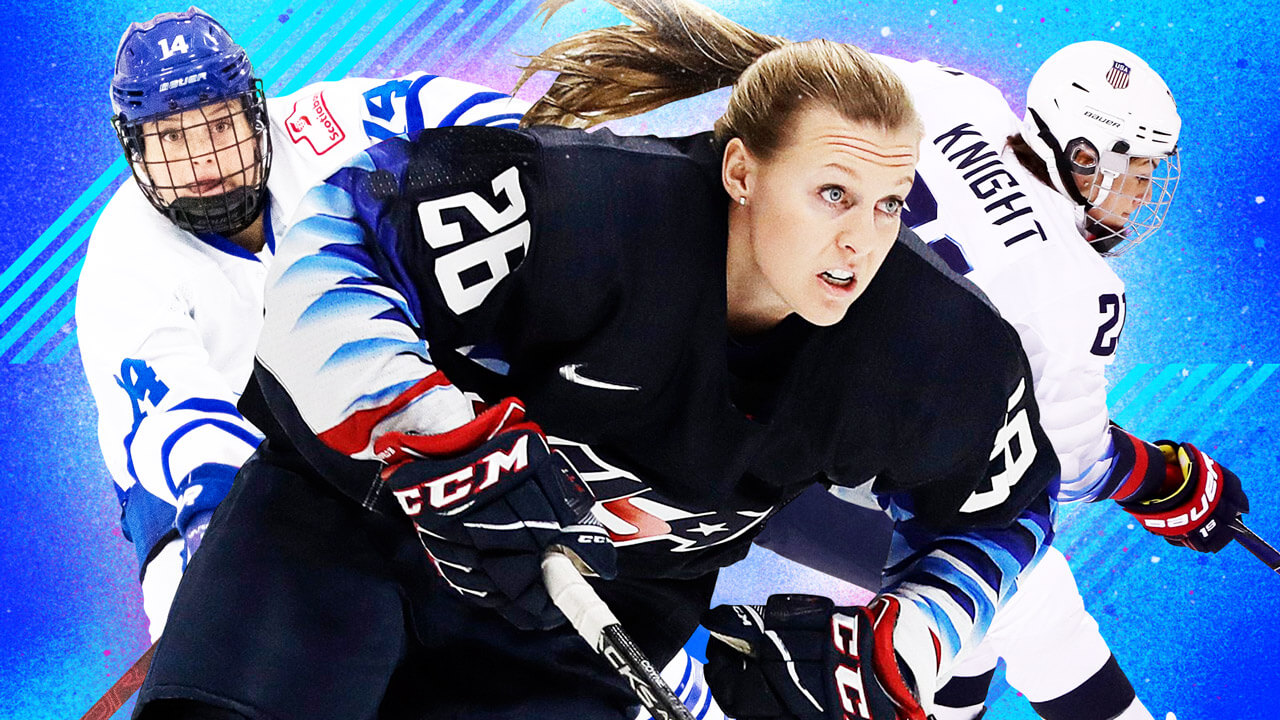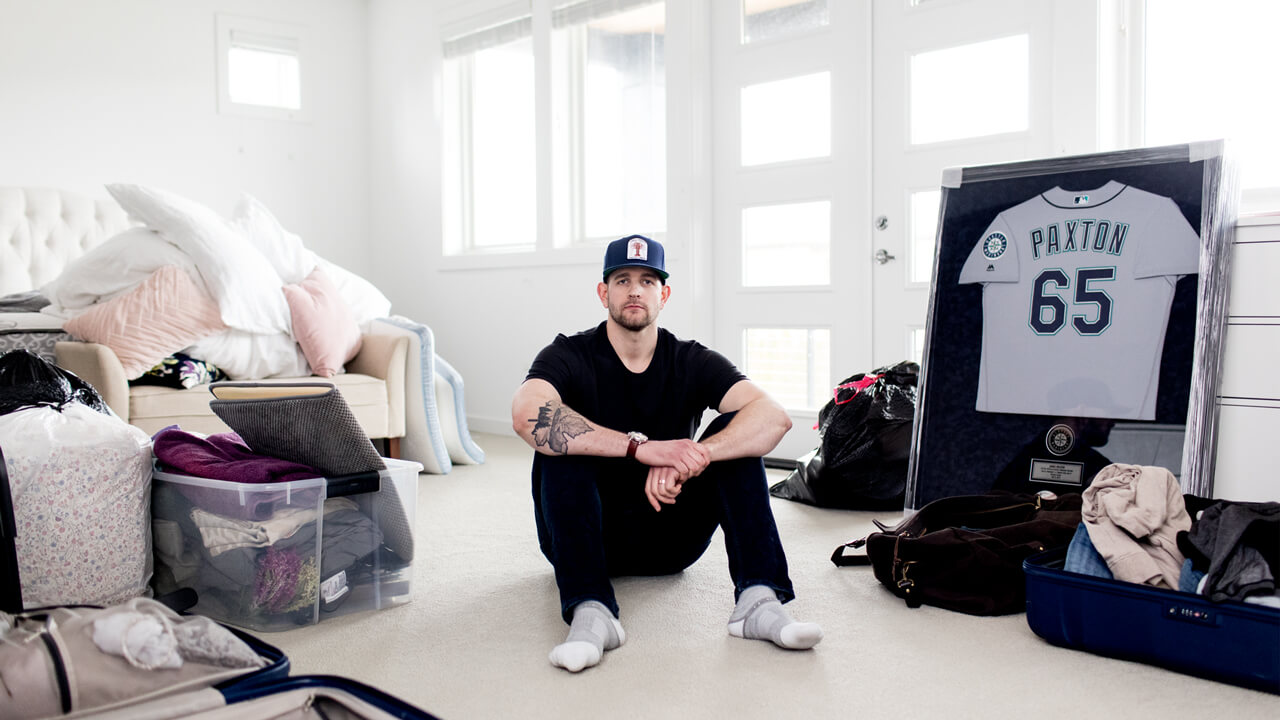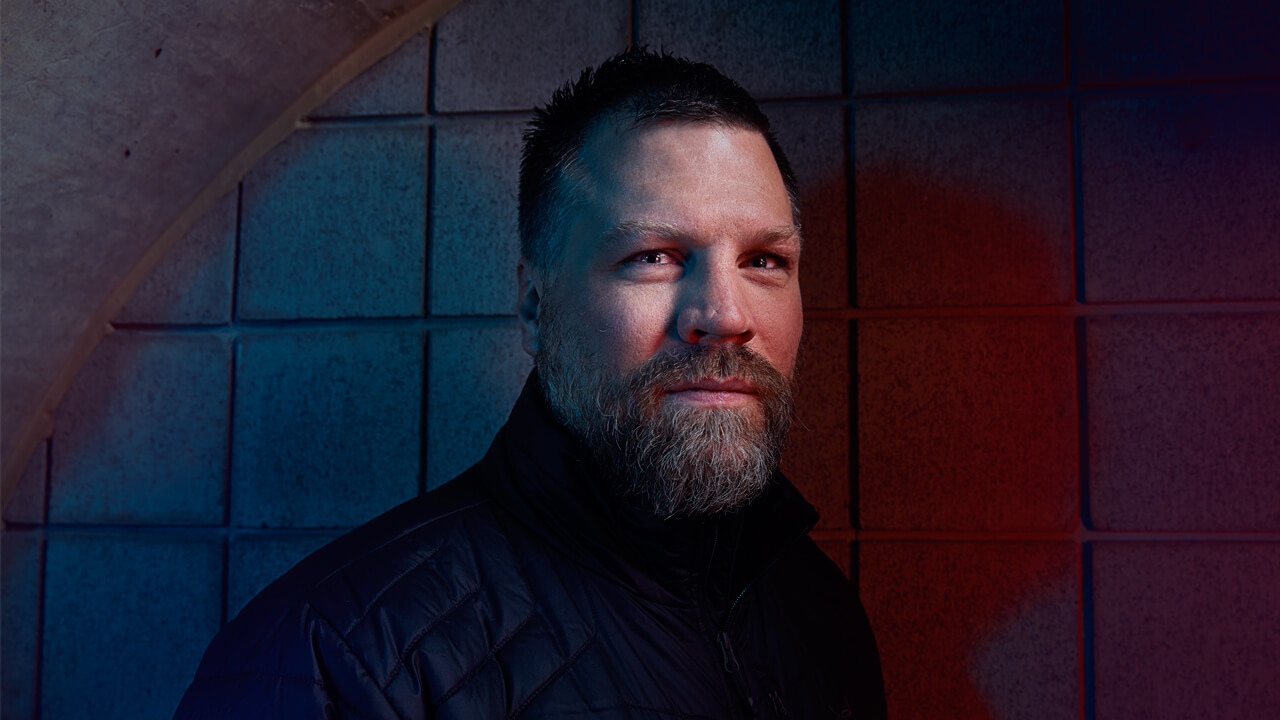When searching for signs of the myth-making magic that comes with playing basketball for the Duke University Blue Devils, Cameron Indoor Stadium is a good place to start. The iconic 9,414-seat arena that sits unobtrusively in the heart of the campus opened on Jan. 6, 1940, and would still be familiar to anyone who was there that first night, when Duke did away with Princeton in a barnburner, 36–27. A two-minute tour of the lobby captures eight decades of college basketball history.
Quite reasonably, much of that history tilts toward the last 39 years, a period that began when a 32-year-old Mike Krzyzewski was hired to re-invigorate a program that had gone dormant just as college basketball was beginning to explode. After arriving in 1980, the tough Polish kid from Chicago via West Point survived three shaky seasons in which the Blue Devils puttered along with a 38-47 record before making his first NCAA tournament in 1984 and then taking his 1986 team to the championship game. On that foundation, he built the leading program in college basketball — the display cases at the arena entrance offer proof.
There is the ‘Coach K 1K Wins Box’ — made from 800-year-old English oak, the Nike-commissioned gift commemorates Krzyzewski’s 1,000th win. Every victory is embossed in leather on the inside, framing 10 stacked gold ‘K’s, one for every 100 wins. Krzyzewski started this season at 1,100 wins — no other men’s coach has 1,000 — and has shown no signs of slowing down at age 72, his hair as improbably jet-black as it was back in 1980. The cases also hold the sneakers he wore while coaching Team USA to one of the three Olympic gold medals they earned under his watch, and a display with the 13 jersey numbers Duke has retired, names that still resonate today — Laettner, Hill and Redick among them.
RJ Barrett, Duke’s 18-year-old freshman phenom from Mississauga, Ont., gazes around at the memorabilia, reminders of the tradition he’s inherited and is charged with enhancing. He fits in well here and loves everything about playing for the Blue Devils: The hype, the ESPN games, the fanatical fan base, the legend stalking the sidelines who invites him and his teammates over for barbecues, the four decades of players with whom he shares common history. Grant Hill and Barrett’s careers at Duke are decades apart, but they both played for the same coach. “We all have that connection to [Krzyzewski] and the connection to the program and so it really feels like a family,” says Hill, who won two national championships at the school as part of a basketball career that earned him a spot in the Hall of Fame this past September. “So it’s sort of a brotherhood or a fraternity or whatever word you want to use to describe it. But you’re also part of a university and network that is crazy — it’s like a borderline cult.”
At Duke, a former president might show up for one game; at a Blue Devils road game, it might be a King.
“The home games, that’s really where you can see everything — every game is packed,” says Barrett. “No matter if it’s like a game we’re going to win by a lot or a close game — everybody’s here. The fans cheer the same way and it’s great. That’s really what I can say about Duke.
“If you come to the home game, you understand the love, and [then] you go on the road and you got LeBron James watching, that’s amazing.”
Just out of practice in preparation for what is annually the most fevered game of the season — Duke versus North Carolina at Cameron — Barrett is giving a tour of the house of hoops he’ll almost certainly be calling home for one year only. He’s just the third Canadian to suit up for Krzyzewski, joining former Olympians Danny Meagher, a hard-nosed banger from St. Catharines, Ont. who was a starter on the foundational teams that helped turn the program around in the mid-’80s, and Greg Newton from Niagara Falls, Ont. who was a team captain as a senior in 1997. Barrett has a chance to do something no Canadian have ever done here: win a national title. He stops at an interactive display where with the touch of a screen he can stare back at a life-size digital image of his six-foot-seven self rotating through a number of power poses, including a ‘brush your shoulders off’ that Jay-Z himself would endorse.
A stream of his highlights is only a couple of touches away, and the choices are getting richer as the season unfolds: How about the best moments from his freshman-record 33-point night in his debut against the University of Kentucky? Or his version of a perfect game — 23 points, 11 rebounds and 10 assists without a turnover against North Carolina State, just the second triple double during the Coach K era and the only one ever by a freshman? Barrett settles on his 32-point outing on the road against Florida State and his solo fast break that ends in a left-handed flush over six-foot-10 fellow Canadian, Mfiondu Kabengele. “There it is,” Barrett says, approvingly. “That was hype.”
Delivering on the hype has seemingly been Barrett’s full-time job since before he entered high school. He began training with the provincial and national team development programs by seventh grade and left home to attend prestigious Montverde Academy in Florida after ninth grade. He dressed for the senior national team the summer he turned 16 and was a U-19 world-champion at 17. That track record has only caused the microscope to zoom in closer, especially with the NBA draft approaching in June and everyone — teams, media and fans — trying to determine if he has what it takes to lift a franchise and go shot-for-shot with the likes of LeBron and Steph and the “Greek Freak.” The attention hasn’t fazed him: As Barrett and fellow freshman sensation and roommate Zion Williamson attempt to bring Krzyzewski and the Blue Devils their sixth national championship, he enters March Madness as one of the most versatile first-year players of the ‘one-and-done’ era and the leading freshman scorer in the history of the powerful Atlantic Coast Conference.
The legend himself approves: “Well, you know in anything, if you have high expectations for an event or a person or something that’s going to happen … a lot of times people or the event doesn’t live up to it,” says Krzyzewski. “In RJ’s case, he’s exceeded the very, very, high expectations I’ve had for him. I knew he’d be a terrific player and kid to coach, but he’s been better.”
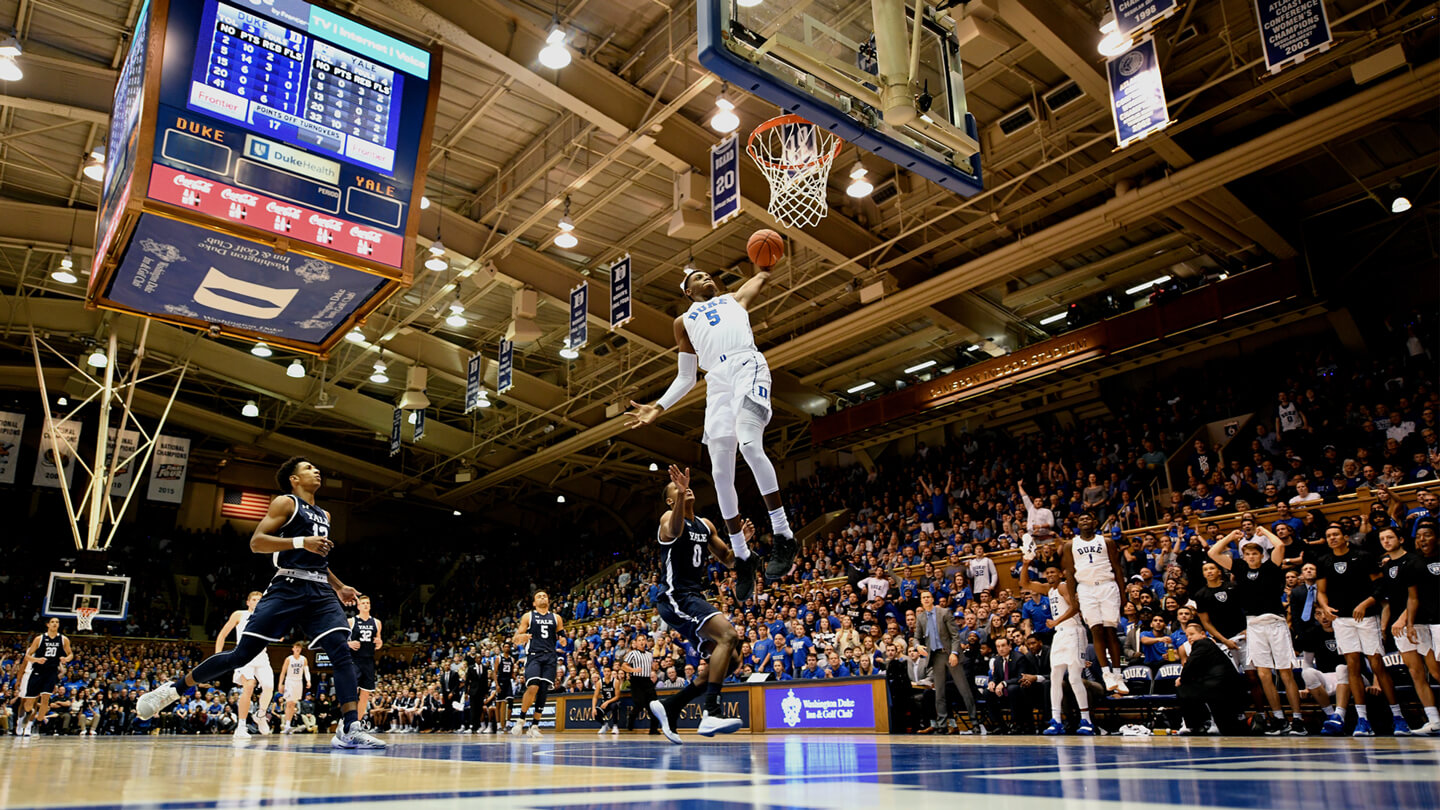
Canadians making a name for themselves at the top of the NBA draft has become virtually routine since Tristan Thompson was taken fourth overall in 2011 — back when Barrett was just getting serious enough about basketball to choose it over soccer as his primary sport. Thompson was a trail blazer. Only two Canadians had been taken in the first round in the previous 15 years and a Canadian had never landed in the lottery as a top-14 pick. Since 2011, there have been 11 Canadian first-rounders and eight lottery picks. Anthony Bennett and Andrew Wiggins were each taken first overall, in 2013 and 2014 respectively.
But Barrett’s challenge is different. Missing amidst the expanding Canadian hoops universe has been a guiding star, the player to take over the mantle left by Steve Nash — Barrett’s godfather and the former Olympic teammate of RJ’s dad, Rowan. Instead, as more Canadians have broken through, enough have fallen short of their promise to raise doubts about how game-changing this country’s hoops explosion really is. Barrett’s in a perfect position to win hearts and change minds. “[For a Canadian] to be this big of a fish in this big of a pond, to me, has never really happened before,” says Dan Shulman, the Toronto-born ESPN play-by-play voice who has called more than a dozen Duke games this season. “It’s exciting and there’s opportunity, [but] there’s also pressure on this kid. I mean he’s supposed to be a first or second [overall] pick. He’s supposed to be a perennial all-star in the NBA. And — by the way, on the side — could you help get us into the Olympics while you’re at it?”
Being great and young is a slippery proposition. Five seasons ago, Wiggins was in the same position Barrett is now — a much-hyped prospect putting in his year at Kansas, which has a program almost as storied as Duke’s. Wiggins went No. 1 after a freshman season that wasn’t nearly as dominant as Barrett’s, but he has spent most of his NBA career being judged a disappointment, with his moments of brilliance standing as exceptions amongst long stretches of ordinary play, or worse.
Even so, Wiggins has fared miles better than Bennett. The wide-bodied leaper from Brampton, Ont. washed out of the NBA after four nondescript seasons and has already gone down as one of the NBA’s all-time draft busts. Thompson? A respected, high-end role player, but not an all-star. Nik Stauskas? He’s played on five teams in five seasons and has yet to find his footing since being taken eighth in 2014. Jamal Murray of the Denver Nuggets is delivering on his promise as the seventh pick in 2016, but the six-foot-four combo guard might not have the ceiling projected for Barrett.
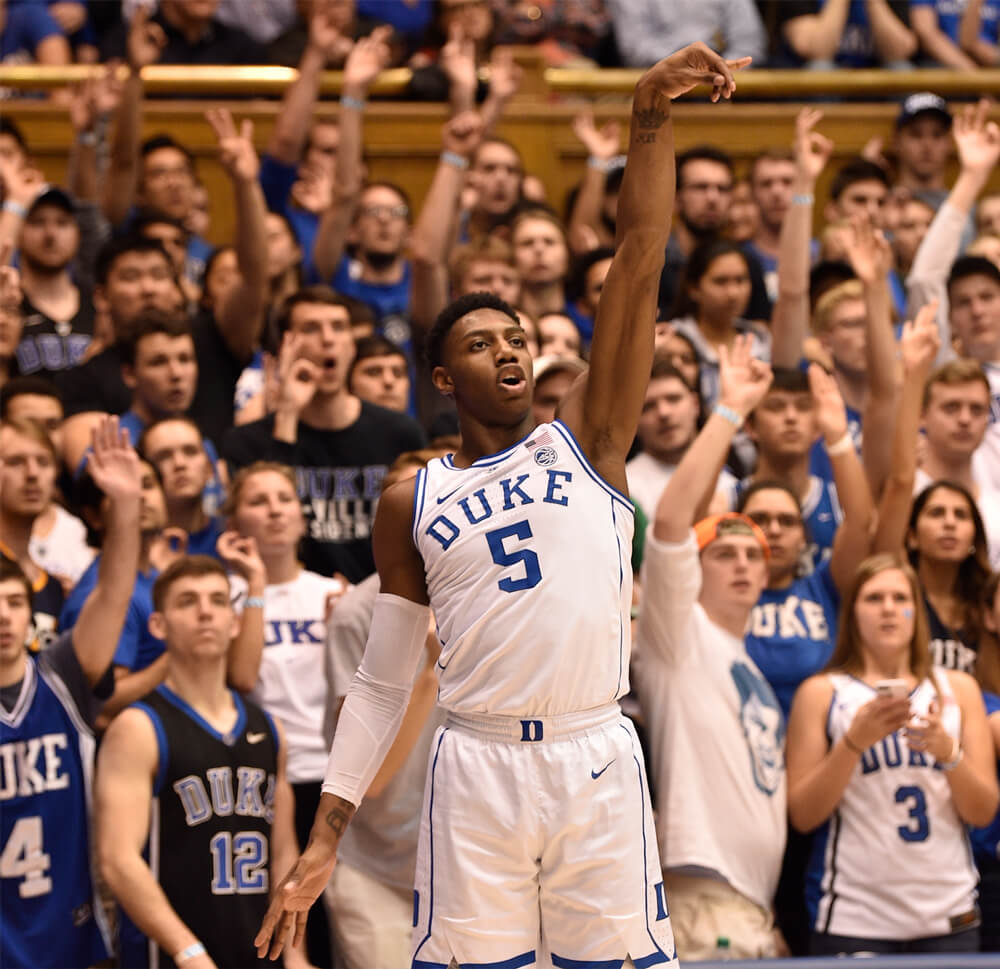
The job of Canadian hoops icon is open. Whether Barrett can fill the vacancy remains to be seen, but he’s at least willing to fill out the application: “I’m just hoping to inspire them, to show that you can do it, you can come from Canada and make a name for yourself,” he says while being interviewed in Duke’s Champions Room, where even the trash cans and ceiling tiles bear the Blue Devils’ logo. “You just gotta believe and just work hard. So I hope that I could be an example for others.”
And be an agent for change: “You know the stigma around Canadians [is] that we’re soft,” he continues. “I’m just trying to, you know, break that tradition.”
Does Barrett actually think anyone believes he’s soft?
“No.”
How could they? He’s smashed through every conceivable challenge before even reaching the legal drinking age back home. At the U-19 world championships in 2017, he stared down Team USA and put up 38 points, 13 rebounds and five assists in the semi-finals. He followed that with 18/12/4 against Spain in the final to lead Canada to its first-ever gold in a global basketball event and earn tournament MVP honours — all while playing two years above his age group. As a senior at Montverde, he led the Orlando-area private school to an undefeated season and a national championship while sweeping every high school player-of-the-year honour in existence, the only player since LeBron James to leave high school similarly decorated.
Not that there aren’t critics and question marks. Play in the spotlight as long as Barrett already has and questions get asked. Will he shoot well enough to be a primary scorer in the NBA? Will he be able to dominate once the size and athletic advantages he’s had to this point disappear? If not, can he transition from being a high-volume alpha to an effective complementary piece? Given how advanced his game is now, how much more upside remains?
For Barrett, all that doubt and investigation comes with the territory. If he’s going to be Canada’s next big thing, he’s not taking the side door.
Which is why Duke was a perfect fit. From Day 1, Krzyzewski handed Barrett the keys. When point guard Tre Jones went down with an injury, Barrett played point. When Williamson is hurt or in foul trouble, Barrett can play big. The Canadian is always given the ball and the freedom to create. Sometimes he looks to the sidelines for guidance and Krzyzewski won’t meet his eyes — figure it out yourself, kid. It hasn’t always worked — against Gonzaga earlier this season the freshman forced up four questionable shots in the final minutes of a close game and missed them all in Duke’s first loss — but Barrett has never backed away. Krzyzewski loves him for it.
“If you’re a really good player and a competitor you play to win, and no one wins every play or every game. But you play to win on every play, and RJ does that,” says Krzyzewski. “There’ll be people who applaud you when you’re successful in those moments and there are people who will criticize you if you are not successful. Neither of those mean anything. What means everything is your attitude and your willingness to put forward your best effort in those critical moments, and I’m all in with RJ.”
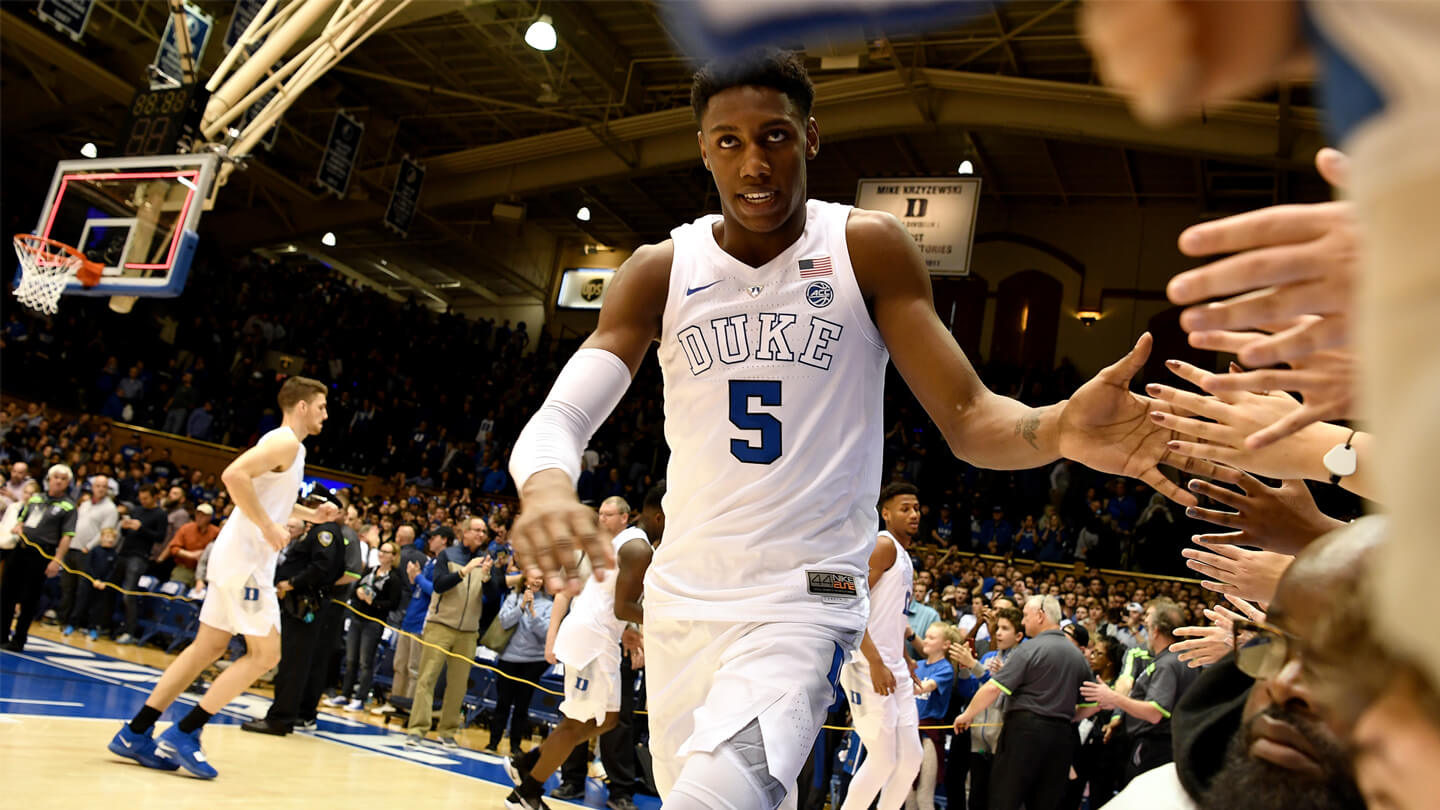
At Duke, developing off the radar is not an option. The high point of the regular-season schedule — and arguably of the entire college basketball schedule each year — is the Blue Devils’ home game against arch-rival North Carolina. The Tar Heels’ campus is just 11 miles down the road and that program counters Duke’s roll call of legends with Michael Jordan, Vince Carter and six national championships to Duke’s five. UNC also owns the edge in the schools’ 250-game lifetime series, 139–111. Jets chartered by wealthy alumni who’ve flown in for the event crowd the nearby private airfield. And hey, wasn’t that filmmaker, Knicks fan and basketball connoisseur Spike Lee who just walked by? This year, rumour has it Barack Obama will be on hand, driving the price for tickets on the secondary market to an average of $4,000 USD, according to reports — Super Bowl levels, in other words.
The doors at Cameron open 90 minutes before the opening tip. The first in the building are the ‘Crazies’ — Duke undergraduates who set up in ‘K-ville,’ the impromptu campsite adjacent to Cameron Indoor that holds 100 tents for up to 12 campers each and goes up shortly after Christmas each year. By rule, each tent must be continuously occupied by a rotation in the weeks leading up to the big game in order to guarantee general-admission spots in the courtside bleachers, which hold 1,200 spectators and roll out just like the ones at your high school — and where the action is most frenzied. You either come to Duke a Blue Devils fan or you become one: “I got into basketball because I lived in the same freshman-year dorm as all the freshman-year basketball players,” says Sanya Kochhar, a third-year student from New Delhi studying computer science, biology and history whose weeks of tenting had earned her a spot courtside amidst the crush of costumed and body-painted diehards. “It was crazy because people would come from other dorms to see them …. I’m not really a big sports-watcher but at some point I thought, ‘I really need to get onto basketball,’ and it has become such a big part of my life.
“My parents think I’m crazy — it doesn’t make sense to them to pay for a dorm and I’m living in a tent — but now I can tell them Obama was here, so I tented for Obama, technically.”
The roar begins about an hour before the ball goes up and never really abates, amplifying when players take the floor for pre-game warm-up. The band, also body-painted, pauses only to let the crowd sing a series of pump-up songs — dance-club hymnals “Everytime We Touch” and “All I Do Is Win” sandwiched around classics like “Livin’ on a Prayer.”
This is what Barrett hoped for when he first stepped on Duke’s campus as a 15-year-old for an informal visit. Though he politely listened to inquiries from the other college basketball powers, it was always Duke’s lead to lose, and Barrett became the first of a talented quartet of freshman — alongside Williamson, Jones and Cam Reddish — to commit for this season, serving as a magnet for the others.
He even helped recruit Williamson, the uber-gifted power forward whose spring-loaded game packed into a dense six-foot-seven, 280-pound frame has made him an Instagram sensation and who has passed Barrett as the presumptive No. 1 pick in the 2019 draft. Being nudged out by his teammate doesn’t seem to have generated any ill will, though. “The way I operate is I want to win, so I’ll do whatever,” says Barrett. “You know my team needs to win and that’s what’s so great about being here is because everybody operates that way.”
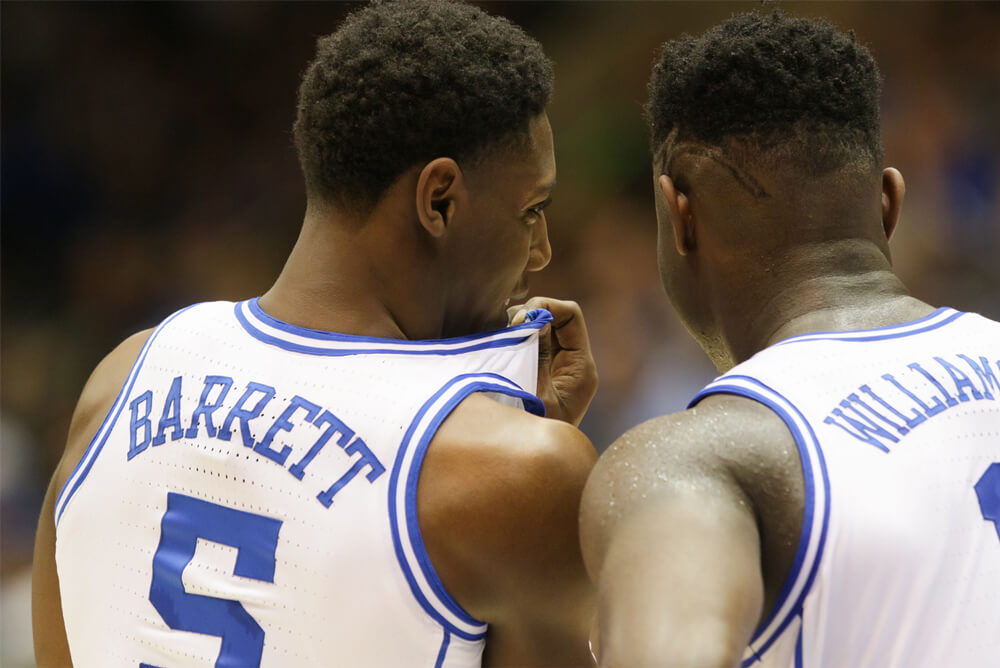
He and Williamson were placed in the same freshman dorm by Krzyzewski on the first day of summer school. The message? If there was going to be a clash of egos between the two star recruits they’d better sort it out early. It is a mark in both of their favours that the pair became fast friends rather than rivals for the spotlight. They spend most of every day together, in class, in practice and at home. Is theirs the most talented rooming arrangement in Duke hoops history? “Well … [let’s say] it’s as talented as any we’ve ever had,” says Krzyzewski.
There are only a small handful of teenagers in the world who can relate to what Barrett and Williamson are going through — sudden fame with millions of dollars lying just beyond their grasp. Fortunately, they have each other. “I learn a lot from him,” says Barrett. “He has the spotlight and he has all the stuff he’s got to deal with. So I pick from him and he picks from me and we actually work pretty well together.”
Their chemistry carries onto the floor, where Barrett regularly looks for Williamson on the break or behind the defence for alley-oops. Against North Carolina State, Barrett needed one more assist for his historic triple-double — he knew because, as he was in-bounding the ball, the Crazies told him he had nine — so he looked for Williamson, who muscled it home for the finish. It is their combined presence, supported by Reddish and Jones, that has those in the know bullish on Duke’s chances to add another title to the display case in the Cameron lobby.
“This team that’s powered by freshmen … you might hesitate to say, ‘Well, they’re the best team, they’re going to win,’” says Jay Bilas, who starred on Duke’s first Final Four team under Krzyzewski and is ESPN’s lead college basketball analyst. “[But] I don’t hesitate with these guys. They’re different. They’re special. There’s never been a freshman class like this, at least in my time around the game. They’re the best I’ve ever seen and operate at a higher level than any freshman class I’ve ever seen.… There’s never been a team that’s played that can’t be beaten, but it’s gonna take an extraordinary effort to beat this one.”
The truth of that prediction will play out in Minneapolis, Minn., site of the Final Four over the first weekend in April. But nothing’s guaranteed between then and now, either. At home at Cameron, the crowd has shockingly hushed for the first time since the team emerged from Duke’s wood-panelled locker room — having met with Obama, who did indeed show. It’s only 36 seconds into the game, but Williamson is writhing on the floor and holding his knee before being helped off, not to return. It will be forever known as the ‘Shoe Game’ as Williamson’s Duke-provided Nike exploded under the stress of his sharp change of direction. The game resumes, but the Blue Devils are off-kilter, even as their home crowd recovers and pumps up the volume again. North Carolina pulls away early and Duke can’t threaten, losing in a rare blowout at home. The story is Williamson, his injury, and whether he should chance coming back to play at all with the NBA millions beckoning.
The risk of injury with a professional career around the corner faces Barrett, too. “You never really think about that,” he says afterwards in a subdued Duke locker room. “You just think about coming in and winning the game. For him to get injured, it sucks. I really hope he’s OK quick.”
Even as the primary focus of opposing defences, Barrett goes on a bit of tear with Williamson sidelined. He finishes with 33 points, 13 rebounds and four assists against UNC and, a few days later, he avenges one of Duke’s few losses with a near-perfect outing on the road, contributing 30 points, five rebounds and seven assists against Syracuse in front of 35,642, the largest crowd to ever watch a college game in an on-campus arena. He averages 26 points, eight rebounds and five assists a game on 50 per cent shooting in the six games it takes Williamson to recover, a reminder of why he arrived at Duke as the presumptive No. 1 pick and on the cover of SLAM Magazine. Even with the spotlight turned into a heat lamp, Barrett never wilts.
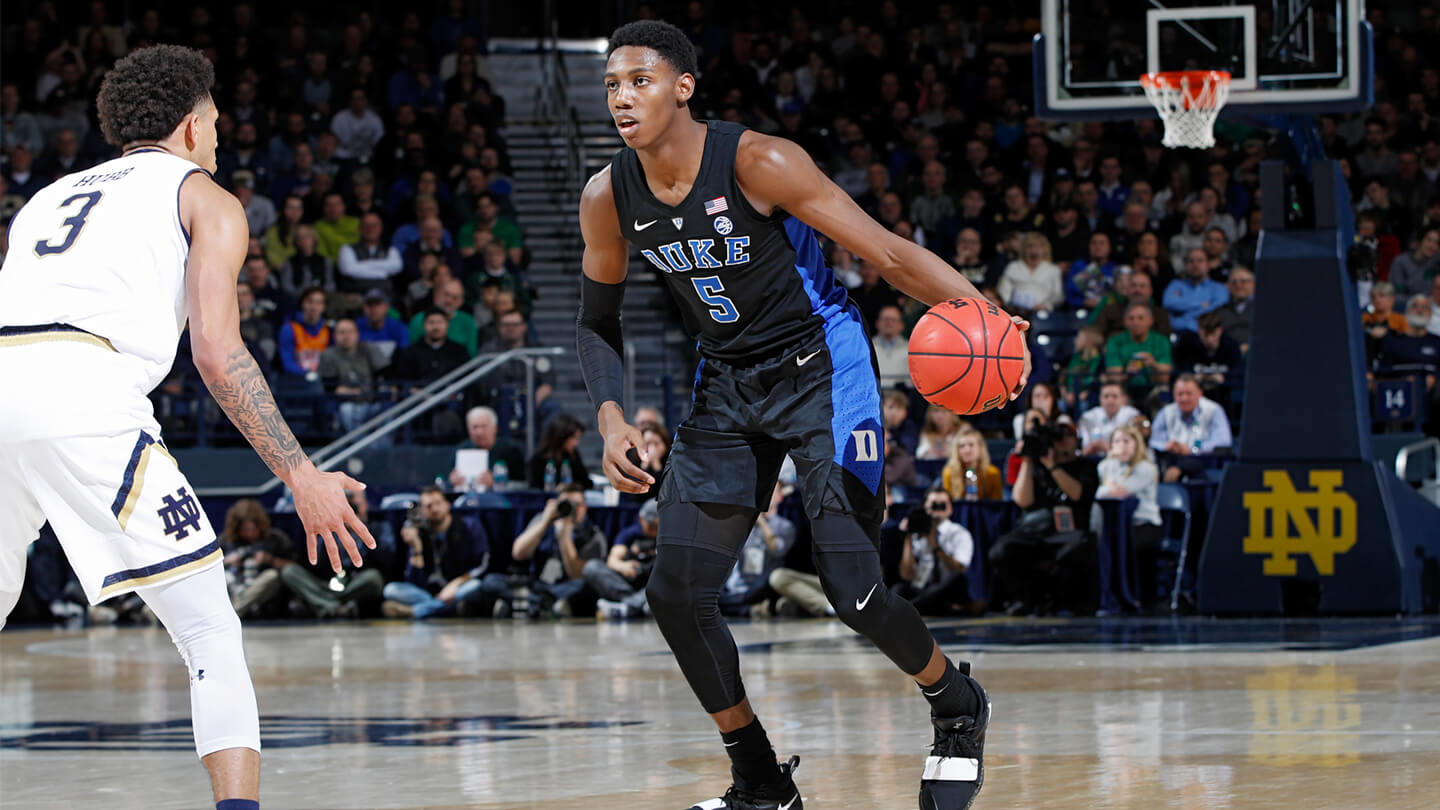
With 30 years of perspective, Hill can see Barrett’s future better than most. He knows what Duke did for him, making him a star before he ever set foot in the NBA. It’s part of the deal you make with the Blue Devil — your star will rise, but after that it’s in your hands. The challenge is to make the experience of playing at Duke, playing for a national title and playing to be one more building block in the Coach K legacy work for you. “You’re under a microscope,” says Hill. “So you have to focus and stay locked in and still produce and be productive under those circumstances. Obviously, [Barrett and Williamson are] going to be aware of things, but for them to keep focused on the goal at hand and focused on each other, it’s remarkable.”
None of the recent wave of elite Canadian ballers has won an NCAA championship, and no Canadian has ever won one in a starring role. No Canadian has won a title at Duke in any capacity. The significance of the opportunity in front of Barrett isn’t lost on him: “I remember winning the gold medal for Team Canada and all the love and support I received at home,” he says. “So I just can’t imagine what it would be like for Canada if we were able to win and I could go back home and say ‘I’m a champion.’ I feel like that would do a lot for our country.”
It would also add to Duke’s legacy and Coach K’s record. By helping him earn his sixth championship, Barrett and his teammates would join an exalted group among the Duke family; it would be their banner hanging at Cameron and their story encased in glass in the lobby.
Pull it off and a little part of Canada will remain at the school forever, on display for all to see. Pull it off and RJ Barrett will still just be getting started.
Designed and edited by Evan Rosser.

